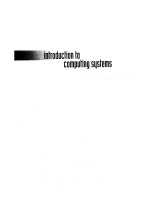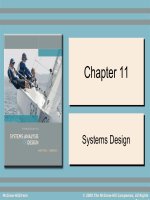Lecture Introduction to computing systems (2/e): Chapter 9 - Yale N. Patt, Sanjay J. Patel
Bạn đang xem bản rút gọn của tài liệu. Xem và tải ngay bản đầy đủ của tài liệu tại đây (649.3 KB, 32 trang )
Chapter 9
TRAP Routines
and
Subroutines
Copyright © The McGraw-Hill Companies, Inc. Permission required for reproduction or display.
System Calls
Certain operations require specialized knowledge
and protection:
• specific knowledge of I/O device registers
and the sequence of operations needed to use them
• I/O resources shared among multiple users/programs;
a mistake could affect lots of other users!
Not every programmer knows (or wants to know)
this level of detail
Provide service routines or system calls
(part of operating system) to safely and conveniently
perform low-level, privileged operations
92
Copyright © The McGraw-Hill Companies, Inc. Permission required for reproduction or display.
System Call
1. User program invokes system call.
2. Operating system code performs operation.
3. Returns control to user program.
In LC-2, this is done through the TRAP mechanism.
93
Copyright © The McGraw-Hill Companies, Inc. Permission required for reproduction or display.
LC-2 TRAP Mechanism
1. A set of service routines.
• part of operating system -- routines start at arbitrary addresses
(convention is that system code is below x3000 or above xCFFF)
• up to 256 routines
2. Table of starting addresses.
• stored at x0000 through x00FF in memory
(but text says that 0x0000 through 0x001F mustn’t be used)
• called System Control Block in some architectures
3. TRAP instruction.
• used by program to transfer control to operating system
• 8-bit trap vector names one of the 256 service routines
4. RET instruction.
• returns control to the user program
• execution resumes immediately after the TRAP instruction
94
Copyright © The McGraw-Hill Companies, Inc. Permission required for reproduction or display.
TRAP Instruction
Trap vector
• identifies which system call to invoke
• 8-bit index into table of service routine addresses
in LC-2, this table is stored in memory at 0x0000 – 0x00FF
8-bit trap vector is zero-extended into 16-bit memory address
Where to go
• lookup starting address from table; place in PC
How to get back
• save address of next instruction (current PC) in R7
95
Copyright © The McGraw-Hill Companies, Inc. Permission required for reproduction or display.
TRAP
NOTE: PC has already been incremented
during instruction fetch stage.
96
Copyright © The McGraw-Hill Companies, Inc. Permission required for reproduction or display.
RET Instruction
Put contents of R7 into PC
• when used at the end of a service routine,
sends control back to user program, just after TRAP instruction
(unless service routine changes contents of R7)
Note: Zero operands – always uses R7.
97
Copyright © The McGraw-Hill Companies, Inc. Permission required for reproduction or display.
TRAP Mechanism Operation
1. Lookup starting address.
2. Transfer to service routine.
3. Return.
98
Copyright © The McGraw-Hill Companies, Inc. Permission required for reproduction or display.
Example: Using the TRAP Instruction
AGAIN
TERM
ASCII
EXIT
.ORIG x3000
LD
R2, TERM
; Load negative ASCII ‘7’
LD
R3, ASCII ; Load ASCII difference
TRAP x23
; input character
ADD R1, R2, R0
; Test for terminate
BRz EXIT
; Exit if done
ADD R0, R0, R3
; Change to lowercase
TRAP x21
; Output to monitor...
BRnzp AGAIN
; ... again and again...
.FILL
xFFC9
; -‘7’
.FILL
x0020
; lowercase bit
TRAP x25
; halt
.END
99
Copyright © The McGraw-Hill Companies, Inc. Permission required for reproduction or display.
Example: Output Service Routine
.ORIG x0430
ST
R7, SaveR7
ST
R1, SaveR1
; ----- Write character
TryWrite
LDI
R1, CRTSR
BRzp TryWrite
WriteIt
STI
R0, CRTDR
; ----- Return from TRAP
Return
LD
R1, SaveR1
LD
R7, SaveR7
RET
CRTSR
CRTDR
SaveR1
SaveR7
.FILL
.FILL
.FILL
.FILL
.END
; syscall address
; save R7 & R1
; get status
; look for bit 15 on
; write char
; restore R1 & R7
; back to user
xF3FC
xF3FF
0
0
stored in table,
location x21
910
Copyright © The McGraw-Hill Companies, Inc. Permission required for reproduction or display.
TRAP Routines and their Assembler Names
vector
symbol routine
x20
GETC
read a single character (no echo)
x21
OUT
output a character to the monitor
x22
PUTS
x23
IN
x25
HALT
write a string to the console
print prompt to console,
read and echo character from keyboard
halt the program
911
Copyright © The McGraw-Hill Companies, Inc. Permission required for reproduction or display.
Saving and Restoring Registers
Must save the value of a register if:
• Its value will be destroyed by service routine, and
• We will need to use the value after that action.
Who saves?
• caller of service routine?
knows what it needs later, but may not know what gets
altered by called routine
• called service routine?
knows what it alters, but does not know what will be
needed later by calling routine
912
Copyright © The McGraw-Hill Companies, Inc. Permission required for reproduction or display.
Example
LEA
LD
LD
AGAIN
ASCII
COUNT
Binary
R3, Binary
R6, ASCII ; char->digit template
R7, COUNT ; initialize to 10
TRAP x23
; Get char
ADD R0, R0, R6
; convert to number
STR R0, R3, #0
; store number
ADD R3, R3, #1
; incr pointer
ADD R7, R7, -1
; decr counter
BRp AGAIN
; more?
BRnzp NEXT
.FILL
What’s
xFFD0
wrong with this routine?
.FILL
#10
What happens to R7?
.BLKW #10
913
Copyright © The McGraw-Hill Companies, Inc. Permission required for reproduction or display.
Saving and Restoring Registers
Called routine -- “callee-save”
• Before start, save any registers that will be altered
(unless altered value is desired by calling program!)
• Before return, restore those same registers
Calling routine -- “caller-save”
• Save registers destroyed by own instructions or
by called routines (if known), if values needed later
save R7 before TRAP
save R0 before TRAP x23 (input character)
• Or avoid using those registers altogether
Values are saved by storing them in memory.
914
Copyright © The McGraw-Hill Companies, Inc. Permission required for reproduction or display.
Question
Can a service routine call another service routine?
If so, is there anything special the calling service routine
must do?
915
Copyright © The McGraw-Hill Companies, Inc. Permission required for reproduction or display.
What about User Code?
Service routines provide three main functions:
1. Shield programmers from system-specific details.
2. Write frequently-used code just once.
3. Protect system resources from malicious/clumsy
programmers.
Are there any reasons to provide the same functions
for non-system (user) code?
916
Copyright © The McGraw-Hill Companies, Inc. Permission required for reproduction or display.
Subroutines
A subroutine is a program fragment that:
•
•
•
•
lives in user space
performs a well-defined task
is invoked (called) by another user program
returns control to the calling program when finished
Like a service routine, but not part of the OS
• not concerned with protecting hardware resources
• no special privilege required
Reasons for subroutines:
• reuse useful (and debugged!) code without having to
keep typing it in
• divide task among multiple programmers
• use vendor-supplied library of useful routines
917
Copyright © The McGraw-Hill Companies, Inc. Permission required for reproduction or display.
JSR/JMP Instruction
Jumps to a location (like a branch but unconditional),
and saves current PC (addr of next instruction) in R7.
• target address is page-relative (PC[15:9] || IR[8:0])
• saving the return address is called “linking”
• bit 11 specifies whether to link or not
if L is set, it’s a JSR
if not, it’s a JMP
Is there another instruction that does the same thing as JMP?
Why wouldn’t we use TRAP?
918
Copyright © The McGraw-Hill Companies, Inc. Permission required for reproduction or display.
JSR
NOTE: Step (1) does not occur for JMP.
NOTE: PC has already been incremented
during instruction fetch stage.
919
Copyright © The McGraw-Hill Companies, Inc. Permission required for reproduction or display.
JSRR/JMPR Instruction
Just like JSR, except Base+Offset addressing mode.
• target address is (Base Reg + zero-extended 6-bit offset)
• bit 11 specifies whether to link -- if not, it’s a JMPR
What important feature does JSRR/JMPR provide
that JSR/JMP does not?
920
Copyright © The McGraw-Hill Companies, Inc. Permission required for reproduction or display.
JSRR
NOTE: Step (1) does not occur
for JMPR.
NOTE: PC has already been incremented
during instruction fetch stage.
921
Copyright © The McGraw-Hill Companies, Inc. Permission required for reproduction or display.
Returning from a Subroutine
The RET instruction gets us back to the calling routine.
• just like TRAP
Note: If we use JMP/JMPR, we can’t use RET!!
922
Copyright © The McGraw-Hill Companies, Inc. Permission required for reproduction or display.
Example: Negate the value in R0
2sComp
NOT
ADD
RET
R0, R0
; flip bits
R0, R0, #1
; add one
; return to caller
To call from a program (on the same page):
; need to compute R4 = R1 - R3
ADD R0, R3, #0
; copy R3 to R0
JSR 2sComp
; negate
ADD R4, R1, R0
; add to R1
...
Note: Caller should save R0 if we’ll need it later!
923
Copyright © The McGraw-Hill Companies, Inc. Permission required for reproduction or display.
Passing Information to/from Subroutines
Arguments
• A value passed in to a subroutine is called an argument.
• This is a value needed by the subroutine to do its job.
• Examples:
In 2sComp routine, R0 is the number to be negated
In OUT service routine, R0 is the character to be printed.
In PUTS routine, R0 is address of string to be printed.
Return Values
• A value passed out of a subroutine is called a return value.
• This is the value that you called the subroutine to compute.
• Examples:
In 2sComp routine, negated value is returned in R0.
In GETC service routine, character read from the keyboard
is returned in R0.
924
Copyright © The McGraw-Hill Companies, Inc. Permission required for reproduction or display.
Using Subroutines
In order to use a subroutine, a programmer must know:
• its address (or at least a label that will be bound to its address)
• its function (what does it do?)
NOTE: The programmer does not need to know
how the subroutine works, but
what changes are visible in the machine’s state
after the routine has run.
• its arguments (where to pass data in, if any)
• its return values (where to get computed data, if any)
925









